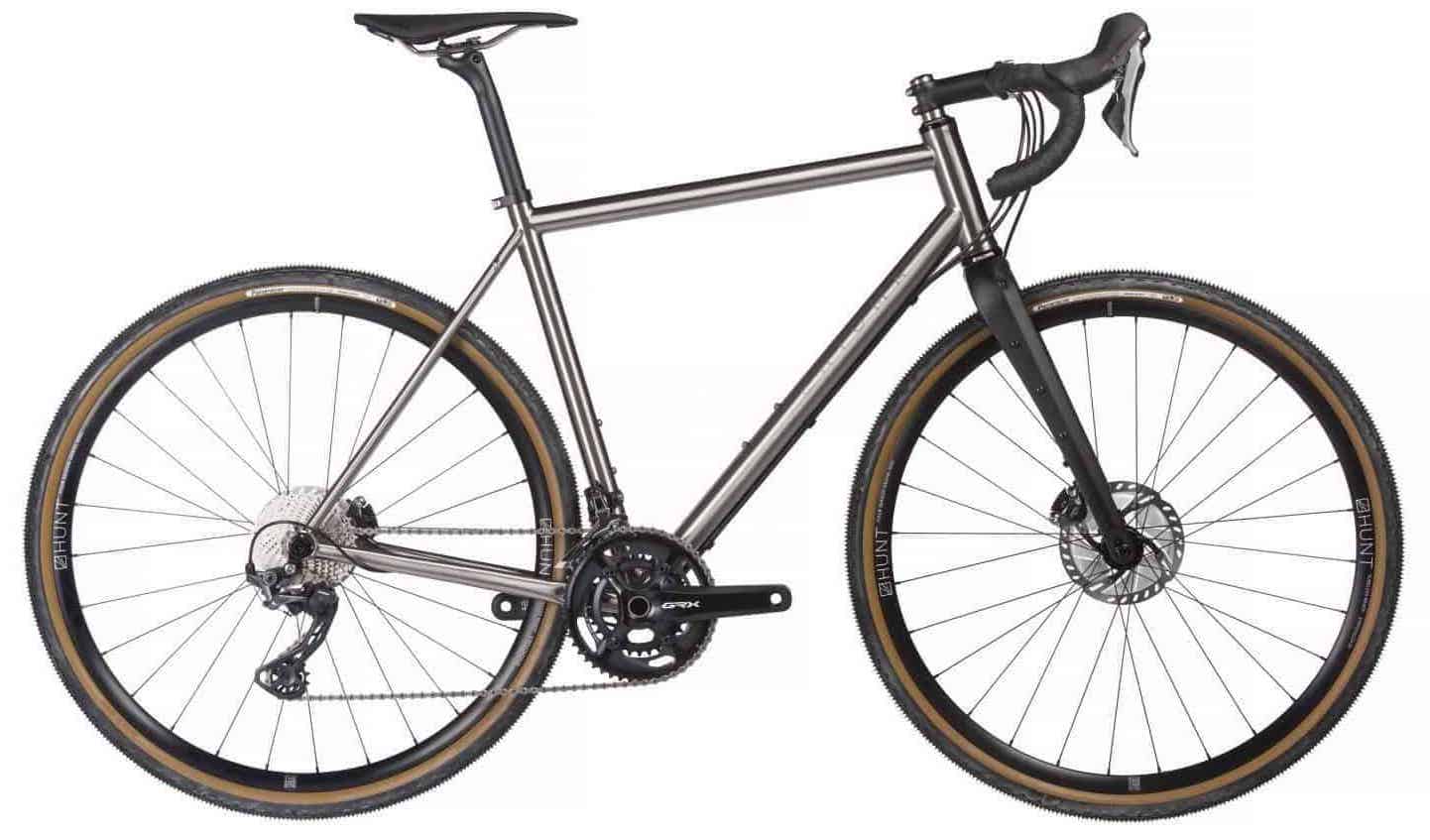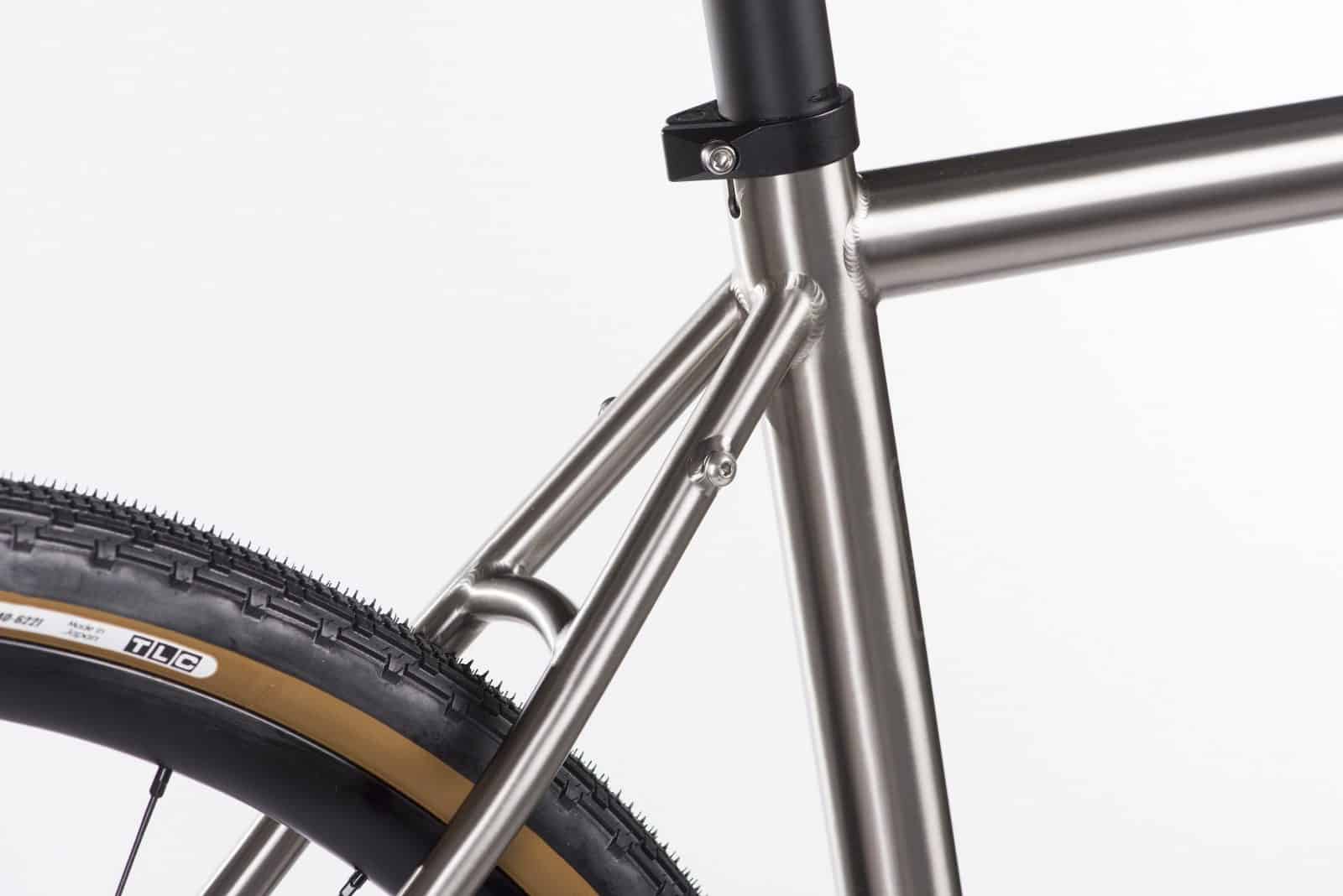My first interview with Ian Hughes was all about the comfort that you can achieve with a carbon frame. This time I spoke to Richard Lambert, Enigma Bikes Sales and Brand Manager, about their Escape titanium gravel bike. I wanted to know more about this bike but also about the advantages of titanium in terms of comfort.
CyclingAbout: Can you introduce yourself to the CyclingAbout readers?
Richard: My role at Enigma is quite diverse, we’re not a huge company so everyone has to be flexible and work well in a few different areas. When I started at Enigma I was mainly involved in custom frame fitting and sales. After a year or so I started looking more at our stock frame design, and now I oversee our entire product range and direction for the brand. I have a particular interest in off-road riding so the development of our gravel bike range has been an area I’ve concentrated on in the last few years.
CyclingAbout: What is the idea behind the Enigma brand?
Richard: Enigma was started in 2006 by Jim Walker, a veteran of the UK bike industry. His goal was to create the world’s most beautiful road bikes, both in appearance and ride quality. Having won various awards over the years including President’s Choice at NAHBS and another at Bespoked, for our 10-year anniversary Exemplar model, I think we can say we achieved this goal! We are now by far the most experienced British titanium frame builder.
CyclingAbout: What was missing on the road bike market in your opinion / what need do you want to fulfill?
Richard: When we started it was a low point for the UK bike manufacturing industry. The big brands such as Raleigh had recently moved production to Asia, and the traditional frame builders were also struggling, many didn’t survive the 90’s and 00’s as Carbon and Aluminium became the material of choice for mainstream brands. Enigma pioneered titanium manufacturing in the UK and remains one of very few British titanium frame builders.
CyclingAbout: Why titanium bikes? What is so special about titanium in your opinion?
Richard: Titanium is renowned for its comfort, it creates a beautifully smooth ride quality. It’s also the best material for durability, not just the frame itself but also the finish. Raw titanium brushed finish is very easy to maintain and lends itself to bikes that are ridden hard! This includes off-road, gravel, and bikepacking… traditional finishes tend to become easily damaged so titanium is ideal for these styles of bike.
CyclingAbout: What is the single most unique thing about Escape bikes?
Richard: I believe this was one of the first batch-produced titanium frames that used size-specific tubing, where we specify narrow diameter tubing on the smaller sizes to increase the compliance for lighter riders and larger diameter on bigger frames to increase stiffness for heavier riders.
CyclingAbout: Yes, this is a very interesting topic because I have heard a lot not only about how comfortable titanium can be but also how much more flex (even compared to steel which my bike is made of and is certainly not the best in terms of stiffness) it provides so as a result, it is not that great in terms of power transfer. Do you agree with that notion and what exactly did you do with the Enigma frame to make sure that it will be stiff enough?
Richard: The most important aspects of the frame design to control stiffness are the tube diameters. Early titanium frames from the ’90s tended to be based on steel tube dimensions, and in titanium, these tube sizes created frames that were not stiff enough for many riders. It led to a lack of confidence descending or problems when loaded up with panniers, as well as the loss of efficiency of course. With older bikes being based on traditional straight steerers and narrow head tube sizes, this limited the tubes you could use, you can’t easily join a large diameter downtube to a skinny head tube. Some of our earliest frames used a biaxial downtube, ovalized at each end so that a larger down tube could be used, but since tapered steerers have become more common we’ve been able to use straight, round tubes and achieve the required stiffness. Our ethos is always to do something in the simplest, most elegant way possible to achieve the required results, and modern standards such as 44mm headtubes, 35mm seat tubes, and T47 bottom brackets give us the greatest surface area to join the other critical tubes and make a very responsive frameset. The lack of stiffness with titanium is therefore no longer an issue.
CyclingAbout: What exactly do you do to make it more comfortable (offer more compliance)?
Richard: As above, the size-specific tubing is one of the main aspects, but one thing that is often overlooked in favor of technological solutions is the fit of the bike! As we sell directly to the public, we meet many of our customers and fit them into the bikes in the factory here. This gives us the opportunity to regularly review the geometry we offer and constantly feedback fit information to the design team. Personally, I have performed over 1000 bike fits in the last 5 years, and I use this experience to make sure our stock geometry gives the best possible fit for our customers. When I talk about ‘fit’ I’m not just talking about the customer’s position on the bike, but also how the frame geometry will impact the comfort. For example, a setup with only a short amount of exposed seatpost, or no headset spacers, will be far stiffer than one with 30mm of spacers and 200mm of an exposed post. This has a big impact on overall comfort.
CyclingAbout: But going back to my question…
Richard: We use our 15 years of titanium and steel manufacturing experience to ensure tube diameters are optimized for both comfort and stiffness. Part of our brand philosophy is that we want our bikes to have a classic, timeless appearance. Something that won’t go out of fashion and still look good in 10 years’ time! We see other brands that try to stand out by using tubing with different shapes, but in our experience, this normally has no impact on compliance and is done for marketing purposes! It’s something that has been going on for decades – from Hetchins steel frames in the 1930s to the latest carbon Pinarello.
CyclingAbout: So you are saying that a trend of using bent and/or thin seat stays to improve compliance is nothing more than marketing? Because I was wondering why not do the same with titanium seat stays. Some titanium frame makers (like Litespeed with Ultimate Gravel bike are doing just that).
Richard: As I touched on before, and you mention it being a ‘trend’, well trends come and go! We build bikes to last. Some of our earlier bikes had curved stays (if you look at our Etape from 2008), at the time we thought it would make a difference, but in testing since vs straight strays, you can’t tell. There are many other aspects of frame design where you can feel a difference but a lot of the tube shaping out there is just a way for a brand to set itself apart from the rest in its marketing. You mention thinner tubing – this is different, of course, a thinner tube will flex more. But if it’s too thin it will either break or be too flexible! It sometimes takes years of testing to work out where the limits are with tube diameters, and what the optimum is for compliance and stiffness.
CyclingAbout: Why did you decide to use a wider (31,6) seat tube diameter when 27,2 is considered a comfier solution?
Richard: As we discussed, one of the challenges of building a titanium frame is making it stiff enough, and when using larger diameter top tubes to make a responsive frame, you require a larger seat tube to join the tubes together effectively. Although our seat tube is 31.6mm internal, you can still use a 27.2mm seatpost to increase comfort, this is something we regularly specify on complete bikes. It also ensures compatibility with dropper posts and for heavy riders with long legs, and a larger diameter post may be preferred. 31.6mm is the most flexible option. This also goes back to the bike fit, and how much post is exposed. Some manufacturers use longer seat tubes to give a traditional look, we appreciate this style but most of the time it makes the bike less comfortable.
CyclingAbout: What do you think about the solutions like BMC MTT, Cannondale Kingpin suspension or Specialized FutureShock? In other words, can a titanium frame without moving parts still compete with this kind of solution in terms of comfort?
Richard: We consider these features to be unnecessary complications rather than anything useful. Many of our staff here rode mountain bikes since the ’90s and it’s not the first time we’ve seen such products. Rockshox made suspension forks for drop-bar bikes 25 years ago. Girvin made flex stems. Cannondale and others made ‘soft tail’ bikes with short-travel suspension and no pivot points. These features have come and gone, riders realized that you’re either better with proper suspension or nothing. I predict the same will happen with road bikes, the ‘innovations’ will turn out to be of no benefit and quietly disappear.
We feel that you can get more than enough comfort from a properly designed rigid frame and fork, that fits well, with the right tires at the correct pressure. Nothing wrong with suspension but we feel that as drop bars limit the off-road capability of a bike it is mostly unnecessary to also have on this style of bike.
CyclingAbout: Why did you go with a 430mm chainstay and not make it shorter for a more agile ride?
Richard: Longer stays will be more comfortable! They will have more compliance, and generally, a longer wheelbase is more comfortable and more stable over rough surfaces. It’s also necessary to have the right tire clearance and room for mudguards.
CyclingAbout: What is in your opinion the limit of a titanium frame in terms of tire clearance when the chainstay is 430mm long?
Richard: There isn’t much room left with a 700x45mm tire, but you can go bigger depending on mudguards, and front derailleur, and you can curve the seat tube to give more clearance. Our 29er MTB frame will fit a 29×2.6″ tire (66mm) with a 435mm stay. but there is no front derailleur or mudguards and the seat tube has a slight curve.
CyclingAbout: How would you compare a titanium Escape bike with a steel Endeavour? Which one offers more compliance and which is stiffer in terms of power transfer? And what about the weight difference?
Richard: The Escape is more compliant, the Endeavour a little stiffer. There’s about a 400-gram weight difference between the frames. They’re very similar really, but some customers prefer steel and may have a more limited budget. They’re both very nice to ride, I see the Endeavour as more of a modern touring bike, it’s better on the road as it’s stiffer, but will handle rougher surfaces with no problem. The Escape is more of a true gravel bike with slightly better off-road comfort due to the extra comfort from titanium.
CyclingAbout: What do you think about the trend of flexing handlebars like Giant D-Fuse or a carbon HollowGram from Cannondale (which is a very flat handlebar with a lot of visible flex)? Can a titanium handlebar compete with that? Do you plan to make one?
Richard: Handlebars made from different materials will feel different, but in our opinion, it’s quite far down the list of what is important for bike comfort. For example, if you start with ‘fit’ as the most important, then tires, pressure, frame material, etc I could come up with quite a list before I got to handlebar material. The shape of the bar is more important than the supposed flex they have built in. We haven’t ever experimented with Ti drop bars, but you might find they were too flexible.
CyclingAbout: 700c or 650b with your bike? What wheels you are using? And what tire pressure when using a 700×43 mm tire and 650bx50 mm tire (both setup tubeless) on an Enigma bike?
Richard: I’m quite tall so I like 700c wheels with 45mm tires, run at about 40psi. 650b wheels with wider tires don’t feel right to me, and if I need to go wider I’ll use my rigid MTB with 29×2.4” tires. I think 650b makes sense for shorter riders otherwise toe overlap is an issue with frame design. Tyre pressure is very much dependent on rider weight and conditions so no easy answer there, other than most people run them too hard!
CyclingAbout: Electric gravel bikes are becoming a strong trend. Do you plan to make an electric version of Enigma in the future?
Richard: One day yes, and we have experimented with the Vivax seat tube-mounted system, but it’s difficult to fit a motor and battery in a titanium frame in an elegant way, so, for now, we do not have any firm plans.
CyclingAbout: What gravel trends in general and in terms of comfort do you see emerging or getting stronger in the coming years?
Richard: I predict the main innovations will be in gear ratios and tire clearance. At the moment gravel bikes are based on road bikes but trying to fit MTB tires. They will continue to take influence from MTB parts such as wider hubs and BB which will increase the tire clearance. Gear ranges will get lower, GRX is in the right direction but still not quite there. I feel the frame comfort does not need any drastic changes, but perhaps the geometry will evolve more, with slacker head angles, and steeper seat angles like recent MTB designs perhaps.
CyclingAbout: Is there a gravel bike that caught your attention recently? And why?
Richard: Enigma Escape Pinion version. Belt drive and gearbox for use in extreme conditions!
CyclingAbout: Richard, thank you very much for this interview.
Richard: Thank you for this opportunity!
—————————————————
Richard has been working in the bike industry for 15 years, initially in sales and bike fitting for various shops around the UK. Starting off fitting customers to stock frames from mainstream brands, Richard later moved to more specialist retailers and worked with several brands offering custom frames, building further on his fitting and industry experience.
This experience proved invaluable with a move to Enigma Bicycle Works in 2016. With several thousand bike fits under his belt, Richard first used his experience of designing custom frames to improve Enigma’s stock geometry and later worked on bringing new models into the Enigma range.
Richard’s love for cycling started off riding mountain bikes in the 90s and later moved into road and touring. He has ridden everything from a World Cup DH track to the Velodrome and completed several long-distance routes such as the Mexico – Canada Tour Divide. This off-road experience has been extremely useful as gravel has infiltrated the road bike world and has been put to use on Enigma’s range of All-Road and Gravel bikes such as the Endeavour, Escape, and Excel GR.










